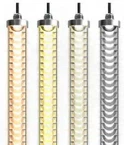The following are some differences between the GB standard for medium voltage indoor metal armored switchgear and the IEC standard:
Standard System and Scope of Application
GB Standard: Developed based on China's national conditions, characteristics of the power system, and practical needs, the GB standard mainly applies to domestic power engineering and electrical equipment manufacturing. It regulates medium voltage indoor metal armored switchgear used in the Chinese market. For example, GB 3906 specifies requirements for AC metal-enclosed switchgear and control equipment operating at voltages from 3.6 kV to 40.5 kV.
IEC Standard: An internationally recognized standard developed by the International Electrotechnical Commission, intended to provide unified technical specifications and reference for electrical equipment manufacturing and power engineering worldwide, such as the IEC 62271 series standards.
Voltage Levels
GB Standard: Defines a clear sequence of voltage levels, such as common values of 10 kV, 20 kV, and 35 kV.
IEC Standard: Some voltage levels differ from the GB standard, such as the specification for a voltage level of 17.5 kV. It is crucial to pay special attention to the correspondence of voltage levels when conducting relevant tests and selecting equipment.
Testing Requirements
Short-Circuit Interruption Test: The GB/T 1984 standard includes electrical life sequence 4, which requires full capacity interruption for 30/50 times, whereas the IEC 62271-100 standard does not have sequence 4, only sequences 1 to 3, where sequence 1 requires 274 times, and sequence 3 requires 72 times.
Temperature Rise Test: The GB standard may require factors like 1.1 times, while IEC generally does not have such stipulations. At a frequency of 60 Hz, the temperature rise under IEC standards is generally 1.05 times that at 50 Hz, with strict testing requirements, including detailed regulations on switchgear sealing and temperature measurement points.
Insulation Test: Both require atmospheric correction, but there may be differences in specific correction parameters and testing details.
Dynamic Thermal Stability Test: According to IEC standards at 60 Hz parameters, the peak withstand current is 2.6 times the short-time withstand current; for example, 31.5 kA corresponds to 82 kA, and single-phase testing for the grounding loop must also be considered.
Protection and Safety Requirements
Protection Level: Although both GB and IEC standards indicate protection levels using IPXX notation, the specific application scenarios and practical requirements for the protection levels may vary. For example, the GB standard tends to focus more on meeting the needs of different domestic environmental conditions, with unique regulations for protection in harsh conditions, while IEC standards place greater emphasis on versatility and commonly applicable international scenarios.
Safety Interlocks: Both GB and IEC standards require switchgear to have comprehensive safety interlock functions, such as preventing misoperation of circuit breakers and preventing load transfer of trolleys with the "five protections." However, there may be differences in specific implementation methods and detailed requirements for interlocks. The GB standard may incorporate domestic operating practices and power system management requirements, resulting in specific assessment criteria for the reliability and durability of interlocks.







